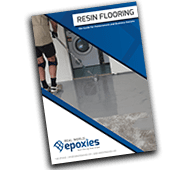Home › Advice › Know How › Knowhow
Are Gloss or Semi-Gloss Epoxy Floors Best?
When do I recommend a full-gloss epoxy floors over a semi-gloss epoxy floor (or vice versa)?
Sounds like a simple question and many people will just tell you: “let the client decide.” There’s nothing wrong with this approach as long as you can educate them effectively on the differences between the two and why one may be more suitable than the other. Below are a few points you’ll need them to consider.
What you expect with a full-gloss epoxy floor
Looking at the fundamentals, a full-gloss epoxy floor will:
- Tend to be resin rich so it can flow to produce the smooth, gloss floor. Being resin rich also means that it might well be more expensive per litre than a semi-gloss floor.
- More readily show imperfections in the floor, so getting the substrate flat and keeping the area closed off tightly are very important.
- More readily show porous sections in the slab where the floor coating has been absorbed.
- May be more prone to colour separation.
What you expect with a semi-gloss epoxy floor (or full matte)
Conversely, a semi-gloss epoxy floor (or full matte) will:
- Often be cheaper per litre as it may have more filler (when talking solvent-borne, pigmented rollcoats at least).
- Not show imperfections as readily. You’ll be able to see divots in the slab, so you should still aim to start with a flat and even substrate, however it will be less noticeable if dust or fluff has ended up in your floor coating.
- Easier for the client to maintain as it might not show dirt and dust as easily and will tend to conceal scuffs and scratches better.
After reading that summary you’d be forgiven for only wanting to apply the more forgiving semi-gloss floor. That might be the case, but I
still think you should always come back to the original answer: let the client decide.

Costs and imperfections can be explained
If your client is set on a full-gloss epoxy floor, you can now at least inform them why it might cost them a little more - the product
might be more expensive, the preparation needs to be more thorough, and you may need to seal the slab or apply an extra coat if the slab
is porous - and why it’s seen as a higher risk in terms of bugs, dust or fluff.
You can read a more general discussion on epoxy flooring cost in a separate know how article.
You should also advise them that day-to-day cleaning of their full-gloss epoxy floor will take a lot more work than a semi-gloss epoxy floor. It also goes without saying that before you offer your client a full-gloss epoxy floor you should’ve tested the product and know you can deliver the result the client is wanting. If you haven’t or you’re not sure then you’re probably better off to not take on the job.
What other reasons have you come to learn for choosing a semi-gloss epoxy floor over a full-gloss epoxy floor?
-
Products - Use topcoats that can achieve both gloss and semi-gloss finishes:
- Ezypoly PU - One-pack, Moisture-cured Polyurethane
-
Systems - Specify flooring systems with options for either gloss or semi-gloss finishes:
- Resin Marble - Metallic Epoxy Flooring System
- Resin Rustic - Concrete Epoxy Flooring System
- Resin Guard - Protective Rollcoat Flooring System
-
Learning - Learn more about gloss and semi-gloss floors, and much more, with our online courses:
- Epoxy Flooring Short Courses
- Bronze Card Course
-
Ask a question - If you have any questions you'd like to ask us about this topic, hit the support button below:
_800x271a.png)
